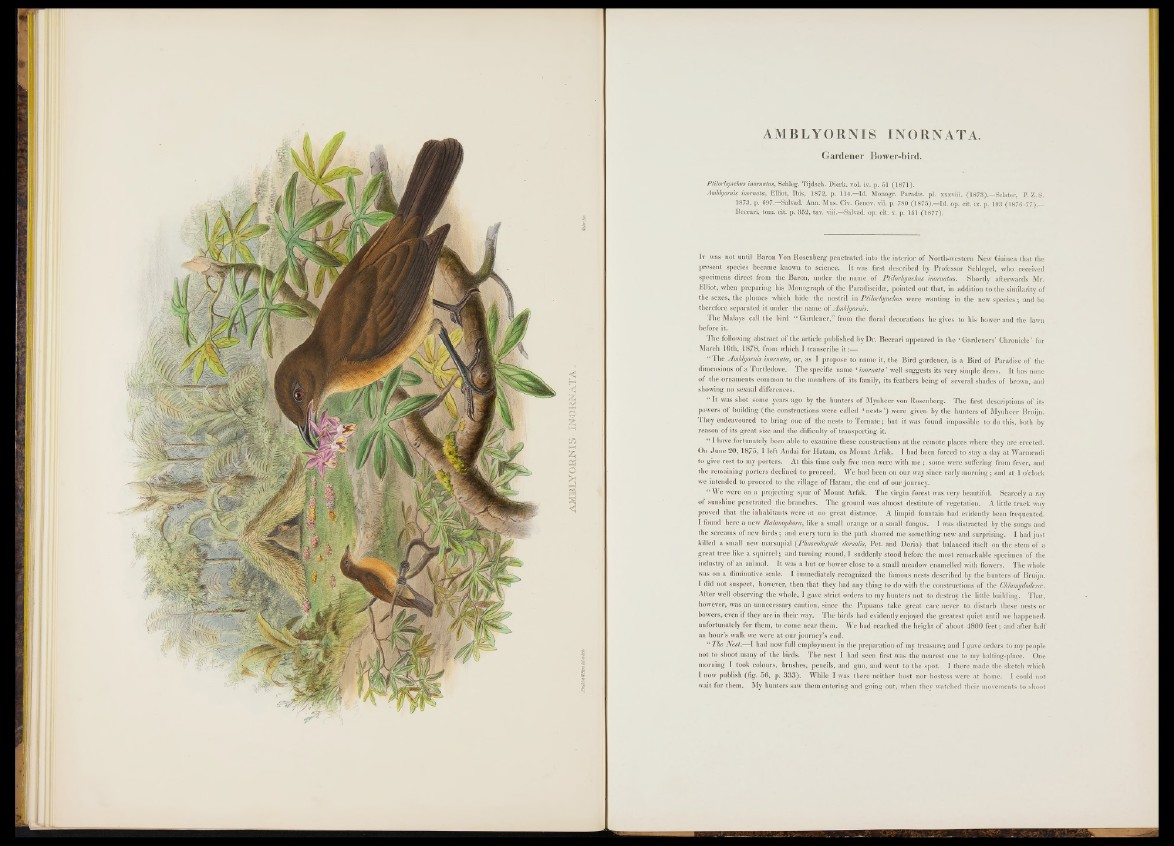
AMBLYOBNXS XN0RNATA
AMBLYORNIS INORNATA.
Gardener Bower-bird.
Ptilorhynchus inornatus, Schleg. Tijdsch. Dierk. vol. iv. p. 51 (18 7 1 ).
Amblyomis inornata, Elliot, Ibis, 1872, p. 114.—Id. Monogr. Paradis, pi. xxxviii. (1 8 7 3 ) Sclater, P. Z. S.
1873, p. 697.—Salvad. Ann. Mus. Civ. Genov, vii. p. 780 (18 7 5 ).—Id. op. cit. ix. p. 193 (1 8 7 6 -7 7 ).
Beccari, tom. cit. p. 352, tav. viii.—Salvad. op. cit. x. p. 151 (18 7 7 ).
It was not until Baron Von Rosenberg penetrated into the interior of North-western New Guinea that the
present species became known to science. It was first described by Professor Schlegel, who received
specimens direct from the Baron, under the name o f Ptilorhynchus inornatus. Shortly afterwards Mr.
Elliot, when preparing his Monograph o f the Paradiseidae, pointed out that, in addition to the similarity of
the sexes, the plumes which hide the nostril in Ptilorhynchus were wanting in the new species; and lie
therefore separated it under the name o f Amblyomis.
The Malays call the bird “ Gardener,” from the floral decorations he gives to his bower and the lawn
before it.
The following abstract o f the article published by Dr. Beccari appeared in the ‘Gardeners’ Chronicle’ for
March 16th, 1878, from which I transcribe i t :—
“ The Amblyomis inornata, or, as I propose to name it, the Bird gardener, is a Bird o f Para’dise o f the
dimensions o f a Turtledove. The specific name ' inornata ’ well suggests its very simple dress. It has none
o f the ornaments common to the members o f its family, its feathers being o f several shades o f brown, and
showing no sexual differences.
“ It was shot some years ago by the hunters of. Mynheer von Rosenberg. The first descriptions o f its
powers o f building (the constructions were called ‘ nests ’) were given by the hunters o f Mynheer Bruijn.
They endeavoured to bring one o f the nests to Ternate; but it was found impossible to do this, both by
reason o f its great size and the difficulty o f transporting it.
“ I have fortunately been able to examine these constructions at the remote places where they are erected.
On June 20, 1875, I left Andai for Hatam, on Mount Arfak. I had been forced to stay a day at Warmendi
to give rest to my porters. At this time only five men were with me ; some were suffering from fever, and
the remaining porters declined to proceed. We had been on our way since early morning; and at 1 o’clock
we intended to proceed to the village o f Hatam, the end of our journey.
“ W e were on a projecting spur of Mount Arfak. The virgin forest was very beautiful. Scarcely a ray
of sunshine penetrated the branches. The ground was almost destitute o f vegetatiou. A little track way
proved that the inhabitants were at no great distance. A limpid fountain had evidently been frequented.
I found here a new Balanophora, like a small orange or a small fungus. I was distracted by the songs and
the screams o f new birds; and every turn in the path showed me something new and surprising. I had just
killed a small new marsupial ('Phascologale dorsalis, Pet. and Doria) that balanced itself on the stem of a
great tree like a squirrel; and turning round, I suddenly stood before the most remarkable specimen o f the
industry o f an animal. It was a hut or bower close to a small meadow enamelled with flowers. The whole
was on a diminutive scale. I immediately recognized the famous nests described by the hunters o f Bruijn.
I did not suspect, however, then that they had any thing to do with the constructions o f the Chlamydoderce.
After well observing the whole, I gave strict orders to my hunters not to destroy the little building. That,
however, was an unnecessary caution, since the Papuans take great care never to disturb these nests or
bowers, even if they are in their way. The birds had evidently enjoyed the greatest quiet until we happened,
unfortunately for them, to come near them. We had reached the height o f about 4800 fe e t; and after half
an hour’s walk we were at our journey’s end.
“ The Nest.—I had now full employment in the preparation o f my treasure; and I gave orders to my people
not to shoot many o f the birds. The nest I had seen first was the nearest one to my halting-place. One
morning I took colours, brushes, pencils, and gun, and went to the spot. I there made the sketch which
I now publish (fig. 56, p. 3 3 3 ). While I was there neither host nor hostess were at home. I could not
wait for them. My hunters saw them entering and going out, when they watched their movements to shoot